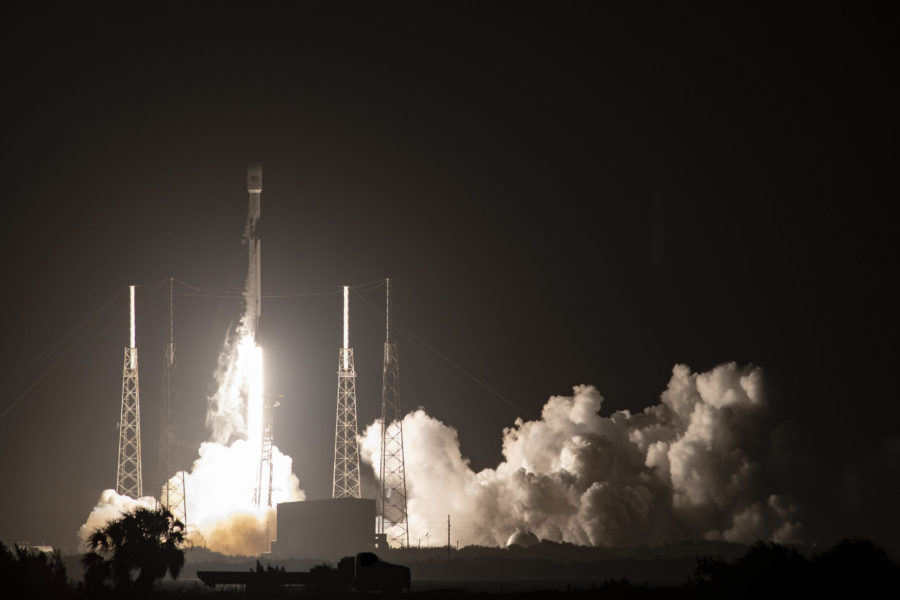The Space Force plans to try out a used rocket booster—a first under the National Security Space Launch program—when it launches the fifth GPS III satellite on June 17.
Prices for the GPS III launches, because of reusability, and to build the satellites, because of the economy of scale, are going down as more of the new satellites enter the U.S.’s GPS constellation. Representatives with the USSF and the two companies providing the satellites and launch vehicles, Lockheed Martin Corp. and SpaceX, answered reporters’ questions June 14. They expect the newest satellite to be up and running in the hands of USSF personnel within about two weeks of launch—shorter than past timelines. The new satellite likely will amount to a modest improvement in GPS location accuracy but with the better anti-jamming and cybersecurity features of GPS III’s.
The USSF saved $54 million when it adjusted the current GPS III launch contract down from $290 million to make reusability an option. The contract covers three Falcon 9 launches, of which this week’s launch will be the second. The USSF will reuse the SpaceX Falcon 9 first-stage booster it used to launch the last GPS III satellite in November 2020. SpaceX captures first-stage Falcon 9 boosters on the decks of drone ships.
In the balance, reusing a booster for the first time amounted to “a little bit of extra analysis,” said Walter Lauderdale, Falcon Division chief and deputy mission director with the USSF Space and Missile Systems Center’s Launch Enterprise.
“Since we’re using the same booster again, we didn’t have to look at all the build paperwork for a first flight—we just had to look at what they did for refurbishment,” Lauderdale said, referring to SpaceX’s refurbishment and the USSF’s procedures to certify a vehicle for flight. “So the resources that we would’ve otherwise dedicated toward looking at the build paperwork, we were able to use that to apply toward looking at refurbishment processes.”
Three more of the 2,300-kilogram GPS III’s are lined up “ready to be called up for launch” in Lockheed Martin’s high bay at its Colorado factory, said Tonya Ladwig, Lockheed Martin vice president for navigation systems. The more powerful and sophisticated satellites can better evade attempts to jam or spoof—in other words, counterfeit a signal via a cyberattack—than its predecessors, Ladwig said.
Lockheed Martin’s contract to build the first 10 GPS III’s planned for the price to drop from about $500 million per satellite at the beginning of the run to about $200 million toward the end. The officials said the current one is probably somewhere in the middle.
The current satellite constellation consists of 31 operational space vehicles, USSF said, and is a mix of GPS IIR, IIR-M, IIF, and GPS III space vehicles. The fifth GPS III satellite will be integrated into the constellation by replacing one of the aging IIR satellites.
The constellation requires a minimum of 24 satellites to meet worldwide coverage requirements, and this fifth GPS III will become the 24th “Military-code-capable” satellite in orbit, providing global coverage for the military’s new, more-secure M-code GPS signal. However, use of that signal won’t be fully operational until 2023, an official said, pending completion of delayed control system software.
In addition to delivering payloads to space, the Department of the Air Force recently announced it would research the feasibility of flying cargo on rockets to destinations on Earth.
The Space Force owns and operates the GPS constellation. Partly because of satellite transfers to the new service, the USSF’s proposed $17.4 billion fiscal 2022 budget amounts to more than 10 percent of the Department of the Air Force’s “blue” budget.
The launch is scheduled for 12:09 p.m. Eastern time on June 17. The launch window is 15 minutes. A second launch window opens at 12:05 p.m. June 18. Lightning from afternoon thunderstorms brought the probability of unfavorable conditions to 40 percent for June 17 and 30 percent June 18, as of the June 14 briefing.
